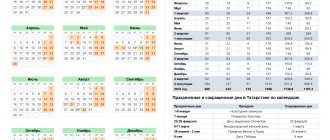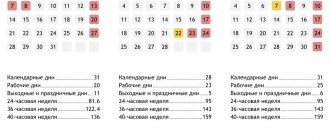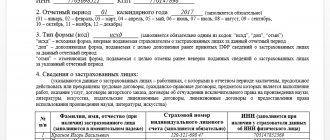Working hours standards for 2021
| Calendar days | Working days | Weekends and holidays | Working hours per week | |||
| 40 hours | 36 hours | 24 hours | ||||
| January | 31 | 17 | 14 | 136 | 122,4 | 81,6 |
| February | 29 | 19 | 10 | 152 | 136,8 | 91,2 |
| March | 31 | 21 | 10 | 168 | 151,2 | 100,8 |
| 1st quarter | 91 | 57 | 34 | 456 | 410,4 | 273,6 |
| April | 30 | 22 | 8 | 175 | 157,4 | 104,6 |
| May | 31 | 17 | 14 | 135 | 121,4 | 80,6 |
| June | 30 | 21 | 9 | 167 | 150,2 | 99,8 |
| 2nd quarter | 91 | 60 | 31 | 477 | 429 | 285 |
| 1st half of the year | 182 | 117 | 65 | 933 | 839,4 | 558,6 |
| July | 31 | 23 | 8 | 184 | 165,6 | 110,4 |
| August | 31 | 21 | 10 | 168 | 151,2 | 100,8 |
| September | 30 | 22 | 8 | 176 | 158,4 | 105,6 |
| 3rd quarter | 92 | 66 | 26 | 528 | 475,2 | 316,8 |
| October | 31 | 22 | 9 | 176 | 158,4 | 105,6 |
| November | 30 | 20 | 10 | 159 | 143 | 95 |
| December | 31 | 23 | 8 | 183 | 164,6 | 109,4 |
| 4th quarter | 92 | 65 | 27 | 518 | 466 | 310 |
| 2nd half | 184 | 131 | 53 | 1 046 | 941,2 | 626,8 |
| 2020 | 366 | 248 | 118 | 1 979 | 1 780,6 | 1 185,4 |
The production calendar is a list of working and non-working days officially approved by the government.
Table of working time standards for 2021
The number of calendar, working, and weekend days, the number of working hours for 40-, 36-, 24-hour working weeks, calculated by month, quarter, half-year and overall year, are presented below:
| Period | Amount of days | Working hours per week | ||||
| Calendar | workers | Weekends | 40 hours | 36 hours | 24 hours | |
| January | 31 | 17 | 14 | 136 | 122,4 | 81,6 |
| February | 29 | 19 | 10 | 152 | 136,8 | 91,2 |
| March | 31 | 21 | 10 | 168 | 151,2 | 100,8 |
| 1st quarter | 91 | 57 | 34 | 456 | 410,4 | 273,6 |
| April | 30 | 22 | 8 | 175 | 157,4 | 104,6 |
| May | 31 | 17 | 14 | 135 | 121,4 | 80,6 |
| June | 30 | 21 | 9 | 167 | 150,2 | 99,8 |
| 2nd quarter | 91 | 60 | 31 | 477 | 429 | 285 |
| 1st half of the year | 182 | 117 | 65 | 933 | 839,4 | 558,6 |
| July | 31 | 23 | 8 | 184 | 165,6 | 110,4 |
| August | 31 | 21 | 10 | 168 | 151,2 | 100,8 |
| September | 30 | 22 | 8 | 176 | 158,4 | 105,6 |
| 3rd quarter | 92 | 66 | 26 | 528 | 475,2 | 316,8 |
| 9 months | 274 | 183 | 91 | 1461 | 1314,6 | 875,4 |
| October | 31 | 22 | 9 | 176 | 158,4 | 105,6 |
| November | 30 | 20 | 10 | 159 | 143 | 95 |
| December | 31 | 23 | 8 | 183 | 164,6 | 109,4 |
| 4th quarter | 92 | 65 | 27 | 518 | 466 | 310 |
| 2nd half | 184 | 131 | 53 | 1046 | 941,2 | 626,8 |
| 2020 | 366 | 248 | 118 | 1 979 | 1 780,6 | 1 185,4 |
FILES
Time tracking
The calculation of hours worked in the PC is pre-divided depending on the length of the working week.
Thus, the legislation of the Russian Federation and in particular Art. 91.92 of the Labor Code of the Russian Federation establishes a scale of working hours per week at 24, 35, 36 and 40 hours, respectively, which the PC, in turn, aggregates on a quarterly basis.
It should be clarified that the PC cannot take into account all specific indicators, for example, the standard working hours provided for by the collective labor agreement at a particular enterprise. Therefore, the upper limits of standard hours are taken into account in accordance with the Labor Code of the Russian Federation, which the accountant and entrepreneur will need to adjust independently depending on the terms of the employment contract.
Accordingly, exceeding the maximum working time limits specified in the PC should be regarded as overtime worked.
Calculation algorithm
The daily rate is calculated on the basis of a working week of 5 days. That is, the maximum working hours - 40, 36, 35 or 24 divided by the number of working days per week.
Accordingly, the resulting daily rate (DN) is multiplied by the number of working days per month in order to calculate the monthly rate (MN).
To establish the maximum working hours for the year, the DV is multiplied by the number of working days for the calculated year.
Holidays and weekend postponements in 2021
In 2021, non-working days in the Russian Federation are:
- January 1, 2, 3, 4, 5, 6 and 8 — New Year holidays (as amended by Federal Law No. 35-FZ of April 23, 2012);
- January 7—Christmas Day;
- February 23 - Defender of the Fatherland Day;
- March 8—International Women's Day;
- May 1 - Spring and Labor Day;
- May 9 - Victory Day;
- June 12—Russia Day;
- June 24 is the day of celebration of the 75th anniversary of Victory in the Great Patriotic War;
- July 1—Voting day on amendments to the Constitution of the Russian Federation;
- November 4 is National Unity Day.
In 2021, non-working holidays on February 23, March 8 and May 9 coincide with weekends, which means they are transferred to the next working days after the holidays - February 24, March 9 and May 11, respectively.
For the purpose of rational use by employees of weekends and non-working holidays, the Government of the Russian Federation, in accordance with Article 112 of the Labor Code, has the right to transfer weekends to other days. Based on Article 112 of the Labor Code, if a day off coincides with a non-working holiday, it is transferred in the production calendar to the next working day after the holiday. Transfer of holidays provided for by the Decree of the Government of the Russian Federation “On the transfer of holidays in 2020” dated July 10, 2021 No. 875:
- January 4 (Sat) → May 4 (Mon)
- January 5 (Sun) → May 5 (Tue)
Pre-holidays in 2021:
- April 30 - pre-holiday day
- May 8th - pre-holiday day
- June 11th - pre-holiday day
- November 3 - pre-holiday day
- December 31st - pre-holiday day
Production calendar for 2021 with a five-day work week
The calendar has been compiled in accordance with the draft resolution of the Government of the Russian Federation on the transfer of days off. It is planned to move the following weekends: from Saturday, January 4 to Monday, May 4; from Sunday 5 January to Tuesday 5 May.
| ||||||||||||||||||||||||||||||||||||||||||||||||||||||||||||||||||||||||||||||||||||||||||||||||||||||||||||||||||||||||||||||||||||||||||||||||||||||||||||||||||||||||||||||||||||||||||||||||||||||||||||||||||
Working time standards
The production calendar will help you find out what dates the weekends fall on in December 2020. He will also tell you the number of holidays and working days and give information about working hours for this month. The last month of the year has 23 working days (including 1 shortened one), as well as 8 weekends and holidays.
Standard working hours:
- with a 40-hour work week - 183 hours;
- at 36 hours - 164.6 hours;
- at 24 hours - 109.4 hours.
In general, everything looks quite simple, but questions still remain, for example, how do we work in December 2021 and days off for the January holidays? Let's look at the last week of December in more detail. We are talking about four days: the 28th, 29th, 30th and 31st - Monday, Tuesday, Wednesday and Thursday... Whether these four days will become working days or the management of some enterprises will allow their employees to rest beyond the New Year holidays - time will tell. For those working five and six days a week, the last official working day of the outgoing year is December 31, and that is Thursday.
Average number of working days in a month
If employees are required to work a 40-hour work week, this typically means that they work 5 days a week, 8 hours a day. Accordingly, there are from 21 to 23 working days per month, unless holidays fall on weekdays. For example, in January 2020 there were only 17 days of labor, in February - 19. The most weekdays were in July and December - 23 days each.
Not all citizens have a five-day work week with two days off. In some cases, the employer may increase it by 1 day. Thus, workers work 6 days, not 5. For such citizens, the number of working days per month accordingly increases by 4-5. For example, in July and December, employees working 6 out of 7 days will work 27 days. It is important to say that even with a six-day period, the 40-hour rule must be observed.
In case of production necessity, according to Article 105 of the Labor Code of the Russian Federation, the working day can be divided into parts. However, even in this case, the amount of labor hours cannot exceed the value specified in the contract.
Production calendar for June 2021 for a five-day work week
The June 2021 calendar is compiled taking into account the following facts:
- June 12 is Russia Day, it is a non-working holiday (Article 112 of the Labor Code of the Russian Federation);
- duration of the working day (shift) before the holiday, i.e. June 11, decreased by 1 hour (Article 95 of the Labor Code of the Russian Federation);
- By Presidential Decree No. 345 dated May 29, 2020, a military parade in honor of the 75th anniversary of Victory in the Great Patriotic War is scheduled for June 24, 2021. This day has been declared a non-working day with continued pay. It must be taken into account that such non-working days are not non-working holidays or weekends.
The current production calendar for June 2021 for a five-day period looks like this (weekends, holidays and non-working days are indicated in red):
How to determine working hours in 2020
As before, the calculation of working hours for 2021 is regulated by Order No. 588n of the Ministry of Health and Social Development of Russia dated August 13, 2009. It establishes the rules for calculating the norm of working time for certain calendar periods (month, quarter, year) depending on the established length of working time per week (5 days, 6 days, etc.).
It is important that the standard working time for 2020 calculated in this order applies to all work and rest regimes in 2020.
Note that for a six-day week, the standard working time is calculated according to a 5-day workweek schedule with two days off on Saturday and Sunday, based on the duration of daily work (shift).
Weekends and holidays
Trying to time their own vacation to coincide with their children's autumn holidays, working citizens focus on the official weekends in October - Saturdays and Sundays. This autumn month will give employees 9 days off. These are the 3rd, 4th, 10th, 11th, 17th, 18th, 24th, 25th, 31st. For those who work six days a week, there are fewer days off: the 4th, 11th, 18th and 25th of the month.
There are no public holidays this month, but regions have their own weekends and holidays in October, for example:
- Day of formation of the Republic of Adygea - October 5;
- Day of the Republic of Bashkortostan - 11th.
There may be others, for example, religious holidays, when workers are provided with days of additional rest.
An unscheduled day off can be declared at any time. Keep track of all changes using the production calendar in ConsultantPlus:
- for a 5-day week;
- for a 6-day week.










